Can Clear Care Plus Hydraglyde Be Used To Clean Soft Contact Lenses?
Caring for your soft contact lenses
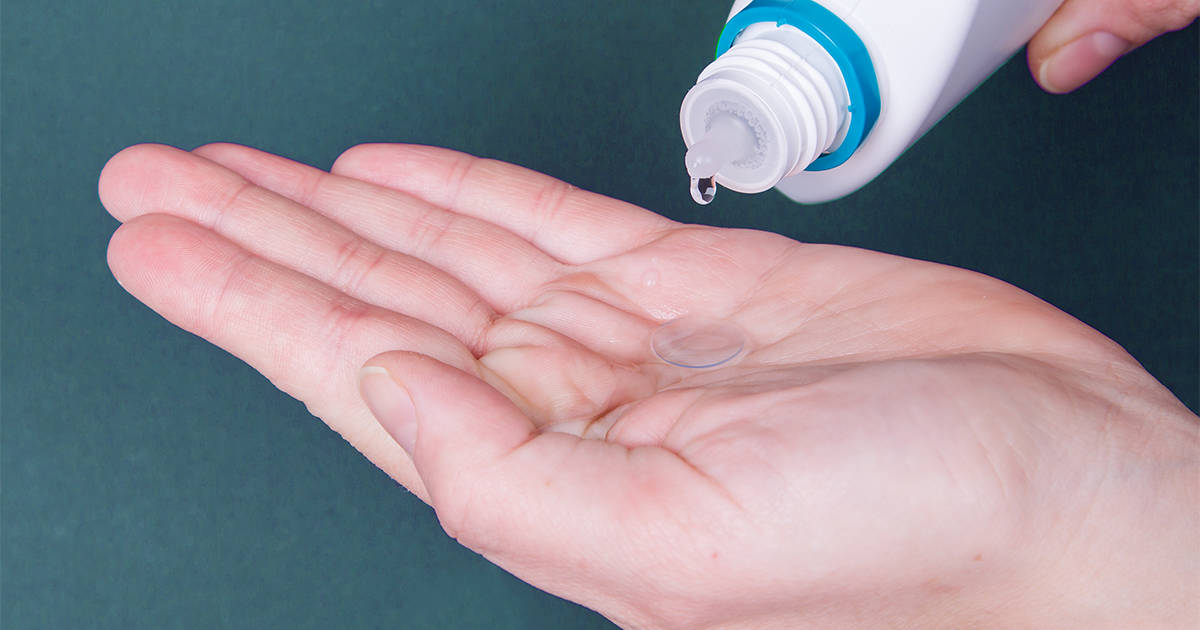
Enter the contact lens care aisle of about supermarkets and drugstores, and you'll notice a disruptive array of products.
Though daunting, it'south essential to empathise lens care: Not caring for your contact lenses properly can lead to a variety of heart infections, including some that cause blindness.
Actually, contact lens care is easier than ever. I-canteen care systems and disposable contact lenses mean that proper lens care involves much less time, expense and trouble than information technology did years ago.
Earlier we get started, understand that yous should non switch care regimens without request your center doctor outset. Some products are not compatible with each other, or with sure contact lenses. Using incompatible products tin ruin your contact lenses or harm your eyes.
To make sense of all the bottles and boxes, it helps to know what steps are required to care for soft contacts.
Information technology's particularly important to follow guidelines for safe handling of soft contact lenses in light of recent outbreaks of serious fungal eye infections associated with a popular (now discontinued) make of contact lens cleaning/disinfecting solution.
The Basics Of Soft Contact Lens Care: Make clean, Rinse And Disinfect
To clean contacts with a multipurpose solution, place the lens in the palm of your hand, use a generous amount of solution and gently rub the lens against your palm with your pointer finger, using a back-and-forth (not round) motion.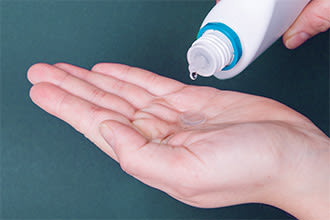
-
Launder your hands and then that you lot don't transfer dirt and germs to your eye. Try to avoid moisturizing soaps, equally they are not good for contact lenses. Dry out your easily with a lint-free towel.
-
Remove one lens and clean it with the recommended solution. Cleaning removes centre-produced buildup, cosmetics and other debris that impairs lens comfort. The FDA recommends that you rub the lens in the palm of your manus with a few drops of solution, even if you are using a "no-rub" product.
-
Rinse the lens again to remove the loosened droppings, making certain to take as long every bit the package directs: Rinsing is an important footstep.
-
Place the lens in your clean lens instance or lens holder and make full with fresh solution; don't "top off" your quondam solution. Disinfecting kills microorganisms on the lens. Disinfection time varies from product to product; check the package for details.
-
Repeat steps two through four for your other lens.
Beyond Clean, Rinse And Disinfect
Protein. Depending on what kind of contact lenses yous clothing and how much poly peptide your eyes deposit on your contacts, your doctor may recommend you use a production for protein removal.
While cleaning them does remove some protein, it tin can still build up on your lenses and make them uncomfortable. That's why the longer you lot wearable lenses before replacing them, the more likely yous are to need a protein remover.
For case, if you wear disposables, you probably won't need 1; but if you wear the kind of lenses that are replaced only one time or twice a year, you definitely will. Products for removing poly peptide include enzymatic cleaner and daily protein removal liquids.
Center dryness and irritation. Use contact lens heart drops to lubricate your optics and rewet your lenses.
Eye sensitivity and allergies. A modest percentage of lens wearers develop an center allergy to the chemicals present in contact lens solutions. If this is the case with you lot, you don't need an boosted production: Y'all just need to switch products to those marked "preservative-costless."
The Products: Cleaning, Rinsing And Disinfecting Solutions
Saline solution is for rinsing and storing contact lenses, when you're using a heat or UV disinfection system. You also may need it for use with enzymatic cleaning tablets or cleaning/disinfecting devices. Never utilise saline products for cleaning and disinfection.
Hydrogen peroxide systems may help wearers who are sensitive to preservatives used in multipurpose solutions.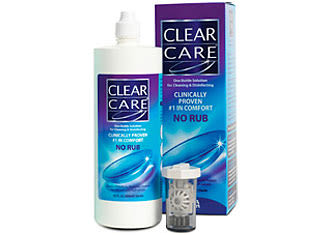
This "extra strength" daily cleaner works for all soft contacts, including silicone hydrogel. It requires rinsing with sterile saline or a multi-purpose solution afterward. This product should never be placed directly in your heart.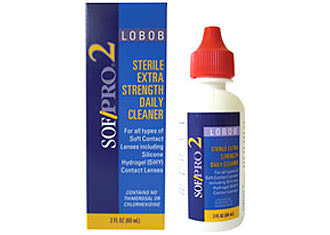
Daily cleaner is for cleaning your contact lenses. You place a few drops in the palm of your hand and carefully rub the lens for as long as directed, ordinarily around 20 seconds, making sure to clean both sides. Utilize other products for rinsing and disinfection.
Multipurpose solution is for cleaning, rinsing, disinfecting and storing your contact lenses. Clean your lenses as you would with daily cleaner, then rinse (equally long equally directed) and disinfect, all with the same solution; or rinse the lenses twice, so place them in the make clean lens instance with solution to clean and disinfect. When you are ready to wear the lenses, rinse them once again. With multipurpose solutions, no other lens care products are necessary.
Hydrogen peroxide solution is for cleaning, disinfecting, rinsing and storing your contact lenses. With this product, y'all place your lenses in the provided handbasket and rinse them, and then place the handbasket in its cup and fill the cup with solution to clean and disinfect your lenses.
Some lens holders for hydrogen peroxide systems accept a born neutralizer (to catechumen the hydrogen peroxide to water, so it doesn't sting your eyes), but with others you need to add a neutralizing tablet.
After the disinfection and neutralizing step is completed, y'all can remove the lenses from the case and put them on.
Never rinse your contacts with hydrogen peroxide solution and apply them directly to your eyes without completing the entire disinfecting and neutralizing step. Doing so can cause a painful chemical injury to the eye.
Brands of hydrogen peroxide care systems for soft contact lenses include Articulate Care (Alcon) and PeroxiClear (Bausch + Lomb).
Cleaning/disinfecting devices will, as you would look, both clean and disinfect your contact lenses. Depending on how the brand is designed, cleaning is accomplished with either ultrasonic waves or subsonic agitation, whereas disinfection occurs via multipurpose solution or ultraviolet lite.
The instructions for the devices are all a trivial different. In general, you start rinse the lenses, using either saline or multipurpose solution equally directed. I brand requires rubbing with the saline, only most are no-rub.
So, put your contact lenses in the device and fill it with the same type of solution as for the rinse. Place the lid on the device and plug it in to make clean and disinfect your lenses.
Contacts And Warts
Q. I just got contact lenses, and as I was removing i of the lenses, information technology slid downwards and touched a wart on my finger. Is it okay to put it back into my heart?
A. Yes, information technology's safe to use a contact lens that has touched a wart on your finger.
Warts on fingers are skin infections caused by viruses of the man papillomavirus (HPV) family. These are different viruses than those that crusade pink eye and other mutual eye infections (which are chosen adenoviruses, herpes simplex viruses and varicella-zoster viruses).
Even so, if your contact lens touches a wart on your finger, it'due south a good thought to rinse and rub the lens with multipurpose disinfecting solution before putting it dorsum on your eye.
As an added precaution against introducing HPV viruses into your centre, see a dermatologist to have the wart on your finger treated. Possible treatments used to remove warts include freezing with liquid nitrogen and laser removal.
You lot likewise can purchase non-prescription topical medications to remove finger warts.
But when using these medications, exist sure to launder your hands thoroughly earlier touching your contact lenses or eyes, as some topical medicines can cause a painful chemical irritation if they become in your optics. — Gary Heiting, OD
The Products: Protein Removers, Eye Drops And Options For Sensitive Eyes
Enzymatic cleaner is for removing protein from your contact lenses, normally on a weekly basis. Y'all use the tablets with saline solution or disinfecting solution (multipurpose or hydrogen peroxide), as directed.
Earlier using enzymatic cleaner, clean and rinse your contacts using other products. Fill your lens case or vials (as directed) with solution, then drop an enzymatic tablet in each lens well or vial. Look for them to dissolve, then add your contacts. Exit them in for the required time, usually 15 minutes.
Afterward, disinfect with some other product if necessary. Certain enzymatic cleaners allow you lot to skip the disinfection step if you use disinfecting solution rather than saline, merely that'south non always the example; check the enzymatic cleaner packaging to detect out.
Daily protein remover too removes protein from your lenses, but it'south in liquid course and yous utilize it daily. Yous employ it during disinfection with multipurpose solution.
Earlier using a daily protein remover, you lot clean and rinse your contacts using other products. Fill both wells of your lens case with multipurpose solution, then add a drop of daily protein remover to each. Disinfect your lenses as usual.
Eye drops for contact lenses are for lubricating your eye and rewetting your contacts. Make sure to choose a brand that is safe for contact lenses. Eye drops that aren't mean for contact lenses can temporarily alter how a lens fits your centre, or discolor the lens.
Multipurpose solutions make caring for your lenses fairly uncomplicated, but remember to rub your lenses as directed, for best results. This one is designed to retain moisture on the contact lens surface so optics stay moist throughout the day.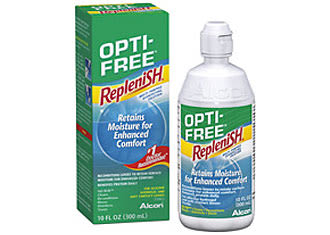
Products for sensitive eyes help people who have allergic reactions to contact lens solutions. These allergies can crop upwardly even if you've been using the same products for years without difficulty. Symptoms may include itching, tearing, strange body sensation, burning, redness and eye discharge. Information technology'due south important to see your eye doctor if you're experiencing these symptoms, every bit they tin can have many causes.
A preservative chosen thimerosal was found to cause problems in virtually ten percentage of patients, so about brands do not employ it present. Thimerosal-free saline is ordinarily marked "for sensitive eyes."
However, people practise have reactions to other preservatives also and need to switch to preservative-gratis care products. Some of these have what's chosen a "disappearing" preservative that's gone before the solution comes in contact with your eyes.
Be certain to pay close attending to the expiration dates on all contact lens solutions, peculiarly preservative-free solutions. Non-aerosol preservative-free saline, for example, should exist discarded inside two weeks after you open it to reduce the hazard of contamination.
What'south Nigh Popular? Ease Of Use
Most soft contact lens wearers these days prefer multipurpose solutions for their contact lens care regimen due to ease of use — only one product is required for cleaning, disinfecting and rinsing the lenses.
But hydrogen peroxide care systems (even though they are a little more cumbersome) sometimes are a ameliorate option — especially if you develop discomfort problems with silicone hydrogel contact lenses.
In a recent study published by Contact Lens & Anterior Centre, using a hydrogen peroxide lens disinfecting arrangement daily significantly reduced mucus and lipid deposits and increased the surface wettability of silicone hydrogel lenses compared with using a multipurpose solution — factors oftentimes associated with greater wearing comfort.
Store Brands
You lot may have noticed that stores like your chemist's shop and grocer sell shop-branded contact lens care products, also known as "private label" products. Often they are considerably cheaper than name-brand products. Should you use them?
These products are condom and FDA-approved, or they couldn't be sold. But at that place are potential problems. Sometimes individual label products are made from older formulations, which don't offer the same advantages as newer products.
But hither's a bigger problem: Every bit yous know, y'all shouldn't switch products without consulting your doc to brand certain the new solution is compatible with your lenses. Allow's say that you purchase a canteen of Shop-brand X, bring it to your medico, and he gives you the OK. Yous use the product, and everything is dandy.
Side by side time yous purchase Store-brand Ten, it may non be the same product. That's because the shop doesn't, of course, make its own solution. They buy it from a supplier. If a better bargain comes along, they might switch suppliers — and even formulations — but still sell the revised production under the "Store-brand X" name. And the revised conception may or may not exist right for your optics or your particular contact lenses.
Contact Lens Intendance Must-Knows
Once you lot've decided which production y'all'd like to try, discuss your plans with your eye doctor. Don't switch brands until you make up one's mind that the new brand is uniform with your other products and with your contact lenses.
Regardless of which intendance regimen or brands you apply, remember:
-
Never impact solution bottle tips to any surface, including your body: this tin can cause contagion of the solution.
-
Avoid getting tap h2o on your contact lenses and accessories, as it can conduct a microorganism called Acanthamoeba that causes serious eye infections.
-
Remember to clean your contact lens accessories (lens case, cleaning/disinfecting devices, enzymatic cleaner vials and so on) as directed.
-
Lens cases should be rinsed with hot tap water and dried when not in use. (Considering Acanthamoeba cysts may exist present in tap water and can survive for years after drying, some eye doctors recommend using just contact lens disinfecting or multipurpose solution for this step.)
-
Recent studies advise that wiping your case with a clean tissue and/or placing it upside-down on another clean tissue may exist additional good steps in keeping bacteria biofilms off the case. Ask your heart doctor what he or she thinks.
-
Throw out your contact lens case every three months to reduce your risk of infection.
Well-nigh importantly, make clean and disinfect your contact lenses once a twenty-four hour period. If you wearable extended wear contacts, make clean and disinfect the lenses every bit before long as you remove them, unless they are designed to be discarded immediately after use. Not only volition your optics be safer and healthier, merely your contact lenses will be more comfy to wear, likewise.
Healthy contact lens habiliment and intendance. U.S. Centers for Disease Control and Prevention (CDC). world wide web.cdc.gov/contactlenses/index.html. May 2017.
Effect of lens care organisation on silicone hydrogel contact lens wettability.Contact Lens & Inductive Eye. Published online ahead of print, July 2015.
The effectiveness of various cleaning regimens and current guidelines in contact lens instance biofilm removal.Investigative Ophthalmology & Visual Science. July 2011.
Bear on of air-drying lens cases in various locations and positions.Optometry and Vision Science. July 2010.
Contact lens and lens storage example cleaning instructions: whose advice should we follow?Middle & Contact Lens. March 2010.
Survival of Acanthamoeba cysts after desiccation for more than 20 years.Journal of Clinical Microbiology. December 2008.
Page published in February 2019
Page updated in January 2022
Source: https://www.allaboutvision.com/contacts/caresoftlens.htm
Posted by: ashworthbeher1938.blogspot.com


0 Response to "Can Clear Care Plus Hydraglyde Be Used To Clean Soft Contact Lenses?"
Post a Comment